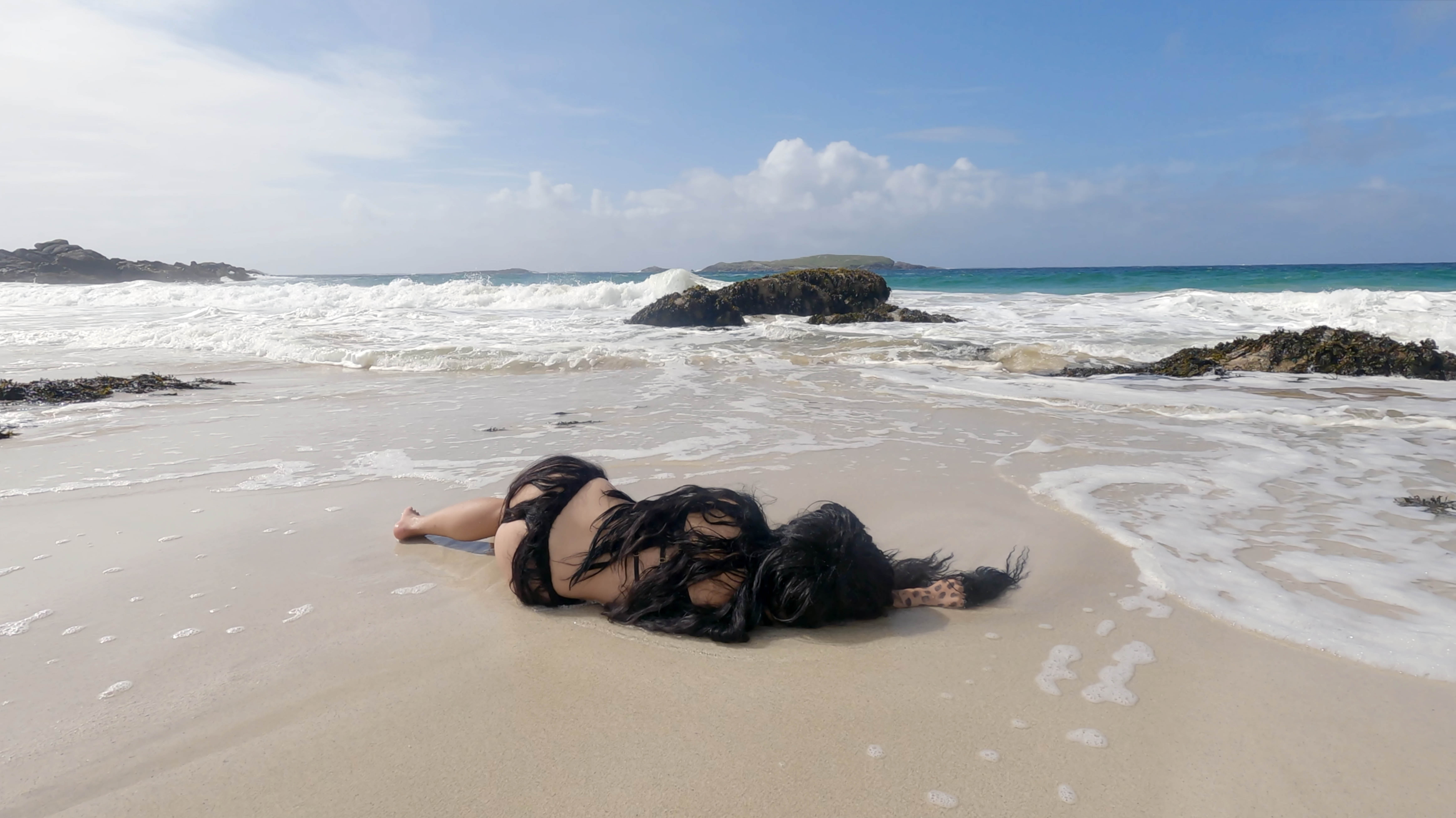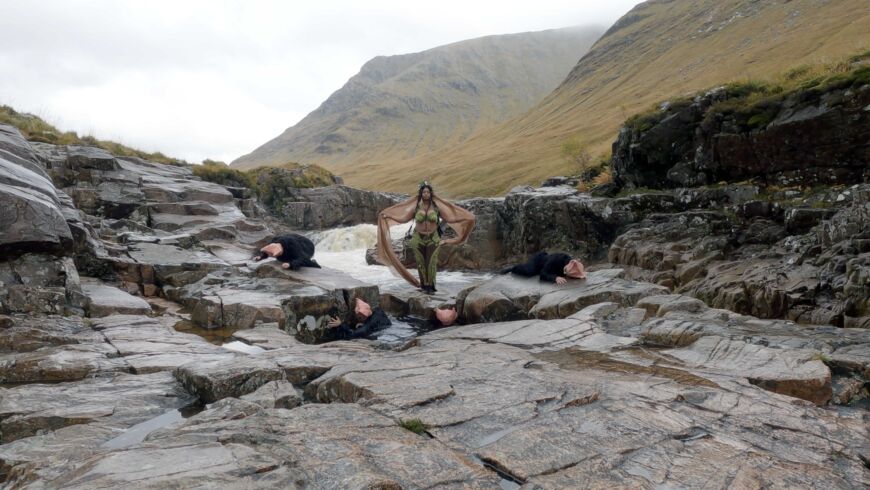Why should our bodies end with our skin?
Undine Sellbach
Intergenerational longings, dislocations and waiting in Soojin Chang's BXBY.
Projects
In the colony lab, where we give birth and finally die, what of our sacrifice and vanishing will remain in the longings of our hybrid seal spawn?
Spotted hand-fins, sprouting hair, the tow of the sea floor. Then air, wind. Limbs shaking, eyes caked in sand. A selkie is swept to a strange isle. Leaving her underwater people behind, she follows Cù-Sìth, the sea dog, fluffy fur, pointed ear, scampering across rocks, in search of land and a way to mate. The island is a vivarium, an artificial home for life. Here at the brink of the given world, old questions press afresh: What is reproduction, and where is it to be found? What are its patterns, mechanisms, elisions? What happens when reproduction is dislocated from these usual locales, rationales and equations? What of the interruptions, vanishing and waiting?
BXBY is a year-long performance work which combines ritual practice with semi-fictional documentary and tales of intergenerational longing, gestation and loss. Channelling the ancestral gods of Soojin Chang and her collaborators – Choulay Mech1, Jade O’Belle, and Aditya Surya Taruna a.k.a Kasimyn, and honouring the mutations of their Korean, Khmer, Yoruba, and Indonesian diasporic hybridities, the performance reinterprets the chimeric myth of the selkie as watery migrant and surrogate of the British Isles. In doing so, it follows Chang, a shape-shifting being – part animal, part woman, part alien – who is trying to learn to reproduce. On this journey, BXBY keeps company with a constellation of feminist and queer scholars who displace the givenness of the body as a reproductive site, and seek to rethink intergenerational inheritance in ways that do not repeat the same.2
When conception is not narrated as the journey of one ‘heroic sperm’, it generally opens with the ovaries. Each month, a cluster of eggs grow in fluid-filled sacs called follicles, until one erupts in ovulation. The follicle then turns into the corpus luteum, releasing a hormone which thickens the lining of the uterus to prepare for the egg. Released, the egg then travels to the fallopian tube and waits. If fertilisation does not occur, the egg passes into the uterus and disintegrates. But when a sperm reaches the egg and burrows in, the egg begins to divide into cells, and then travels down the fallopian tube into the uterus, where it implants in the lining.
Divested of waiting, shedding and bleeding, the ‘moment’ of conception has significant categorical implications. In biology, the ability to interbreed reproductively, inaugurates species membership (with the proviso that sexual reproduction is just one of many kinds of reproduction in nature including spore production, viral infection and bacterial genetic recombination).3 In the case of human pregnancy, conception (moderated by contraception and guided by heteronormative futures) is said to inaugurate happy families. Even when this narrative is challenged in the face of systemic inequalities, vulnerability, labour and risk, it would still seem that reproduction ‘happens in bodies, and lives flourish or become precarious in birth, pregnancy, and infancy.’4
Yet ‘why should our bodies end with our skin?’5 Feminist philosopher and evolutionary biologist Donna Haraway first posed this question in her 1985 essay on the fleshy figure of the cyborg, returning across the course of her writing in the company of apes, dogs, microbes and a shape-shifting spider. For Haraway, these are ‘creatures of imagined possibility and creatures of fierce and ordinary reality; the dimensions tangle and require response’.6 Her work has been influential in drawing attention to the wider field of embodied relations - technological, environmental, gustatory, mythical and microbial – from which reproduction and its disruptions emerge.
Thinking through these fleshy entanglements, technoscience scholars working at the intersection of feminist, trans, queer and disability studies have traced the assisted dimensions of reproduction.7 In the context of in-vitro fertilisation and other reproductive technologies, fertilisation is recast as a social and technical ‘achievement’, enrolling multiple agents (e.g. hormones, eggs, sperm, expectant parents, storage banks, biotech companies), arising from uneven bio-tech, social and economic labours, in ways that selectively foster some lives and disallow others. Not confined to human pregnancy, the reproductive capacities of animals, plants, and many other organisms are cultivated or curtailed as bio-capital through agricultural practices, chemical industries and environmental management policies.8
Indigenous scholars have shown the intergenerational reverberance of trauma, and the amplification of this, through toxic environments and climate precarity, and the importance of care as co-becoming.9 Attentive to these concerns, feminist technoscience scholar Michelle Murphey draws attention to the extensive infrastructures – agricultural, economic, state, military and chemical – which ‘alter, rearrange, foreclose, harm, and participate in the process of creating, maintaining, averting, and transforming life in inter-generational time.’10 She coins the term distributed reproduction to describe the nexus of physical structures, institutional practices, colonial legacies, cultural norms and chemical flows that ‘permeate’ life. In the context of industrial chemicals, some dissipate, some are absorbed and do immediate damage, while others ‘provoke effects that take generations to see, as they slowly injure organisms, ecologies or even planetary atmospheres’.11 While reproduction is conventionally cast as anticipatory, generative and forward reaching, Murphey reminds us of the lag between exposure and symptom and the inheritance of ‘thwarted life’. Through chemical latency, the past is ‘reactivated’, and the future is already altered.’12
The very categories and techniques of the sciences which are deployed to study reproductive bodies and ecologies, and to model alteration, stability and precarity over time, are haunted by violent histories of colonialism and slavery. As feminist scholar Zakiyyah Iman Jackson has argued, western scientific discourses on the origins of life, reproduction and immunity rest on colonial ideas that conflate sex, species and race, sustaining the fantasy of nature as an endless resource. She asks us to consider what might happen if the terms sex, species, and race were not equated as figures of violent othering, but set in mutual relations of vulnerability and debt.13
There is swelling, there is swelling, but no egg in me to be found. Oh, my dear, oh my heart I am ready for that forceful sound.
After the deer is shot the gut is tied in a knot, and the stomach and udder are removed in order to protect the flavour of the meat. This is an old female deer, the hunter tells Chang, as she films the scene. She would not have survived much longer, the teeth are worn down, yet when they remove her back passage, they find a small translucent womb with an embryo inside and the corpus luteum. Through meat eating, humans sacrifice selected animal flesh to gather together as kin.14 In capitalist cultures, animals model human bodies in laboratory experiments, and animal products are unthinkingly circulated and consumed, and this debt, this sacrifice is elided. Yet through ritual there may also be the possibility of recalibrating power between slaughtered animal and slaughterer – her blood pours, power seeps across the land. Not a simple reversal of power relations, but an instability, an opening to uncomfortable proximities, dependencies and seepages.
As my warm plastic fingers inside me, electricity.
Could there be a different performative, a turning of ritual through animist techniques of embodying and remembering?15 Can the ‘estrangement’ of reproduction from its usual home, opened up by science fiction, allow for a different ‘contact with flesh?’16
In BXBY, here in the vivarium, just beyond the brink of the given world, the rituals of the laboratory mix with the labours of bath-time, bedroom, kitchen. Chang positions her hybrid body amidst technical, elemental and gustatory processes in an ongoing relation of experiment. Sampling diverse scientific methods such as IVF, biohacking, and voluntary self-touch, Chang’s performance subverts the hauntings of colonial science towards a thinking-feeling of queer, interspecies kinships and reliance. This is not the auto-poetic ‘self-making’ that too easily reanimates fantasies of autonomy, immunity and appropriation, but ‘a making-with’17 where composition is inflected by discordance, indigestion by gestation, generation with loss.
Soup pot, roe deer-embryo, test tube, freezer, warm bath, microscope, perfume, bat gift. Speculum – a plastic instrument put into a long narrow part of the body to open it up to view; a way to test if the waters are breaking; an area of brightly coloured feathers, commonly on a bird.
Carried by the ungiving river, crouching, seal spawn, swallowed. Ogre daughter, mother, lover, torn-hair, circle of trees, swimming in the rainwater crater, ancestors and afterlife companions. In this intergalactic romance, in these discarded yearnings, who is listening and who is speaking, who is host, guest or passing blurs.
In a past life, I dream you were the daughter and I an elephant with wings and it was our departure in the night,a voice guides the feathered moped rider along the silent screeching highway. I don’t know what will happen, who you will live with, how long I will live. Will your land be swallowed by water, will my house burn down? Where is my home but my abandoned body that I grow out of?
How to host such dislocations, vacations, dispersals.
1 See Soojin Chang and Choulay Mech, Tracing Pre-Emergence Through Performance: the Unequal Representations of Ecological Violence as Seen Between Kreung Animal Sacrifice in Ou Chum, Ratanakiri and Buddhist Funerary Rituals of Phnom Penh, The Glasgow School of Art, 2020.
2 See Donna Haraway, Staying with the Trouble, Durham 2016; Luce Irigaray, Speculum of the Other Woman, New York 1985 and Lynn Turner, The Poetics of Deconstruction: On the threshold of differences, London, 2021.
3 See Susan Squier, Interspecies Reproduction: Xenogenic Desire and the Feminist Implications of Hybrids, London 1998.
4 The assumption that reproduction is naturally fitted to the scale of bodies is questioned by Michelle Murphey ‘Distributed Reproduction, Chemical Violence and Latency’, S&F Online, special issue Life (un)LTD: Feminism, bioscience, race, 11.3, 2013, p. 2.
5 Donna Haraway, ‘Manifesto for Cyborgs: Science, Technology and Socialist Feminism in the 1980s,’ Socialist Review, vol. 80, 1985, p. 65.
6 Donna Haraway, When Species Meet, Minneapolis 2007 p. 4.
7 See Sarah Franklin, Biological Relatives: IVF, Stem Cells, and the Future of Kinship, Durham 2013 and Malin Ah-King and Eva Hayward, ‘Toxic Sexes: Perverting Pollution and Queering Hormone Disruption’, O-Zone: A Journal of Object-Oriented Studies, Vol 1: Object/Ecology, 2013.
8 See Nicole Shukin, ‘Capitalism’, in Lynn Turner, Undine Sellbach, and Ron Broglio (eds) The Edinburgh Companion to Animal Studies, Edinburgh, 2018, pp. 94-114.
9 See Winona LaDuke, All Our Relations: Native Struggles for Land and Life, Boston 1999; Sandie Suchet-Pearson, Sarah Wright, Kate Lloyd and Laklak Burarrwanga on behalf of the Bawaka Country, ‘Caring as Country: Towards an ontology of co-becoming in natural resource management’, Asia Pacific Viewpoint, vol. 54 no. 2, 2013, pp.185–197 and Kim TallBear ‘Identity is a Poor Substitute for Relating: Genetic Ancestry: Critical Polyamory, Property and Relations’, Routledge Handbook of Critical Indigenous Studies, London 2021, pp. 467-478.
10 Murphey, 2013, p. 2.
11 Ibid.
12 Ibid., pp. 2-3.
13 See Zakiyyah Iman Jackson, Becoming Human: Matter and Meaning in an Antiblack World, New York 2020.
14 See Kelly Oliver, Animal Lessons: How They Teach Us to Be Human, New York 2009.
15 See Undine Sellbach and Stephen Loo, ‘The Blind & Deaf Highway Woman’, The Creative Critic: Writing as/about Practice, London 2018, pp. 123-128.
16 Jackson, 2020, p. 121.
17 See Haraway, 2016, p. 58.
—
Undine Sellbach is a philosopher, artist and Senior Lecturer at the University of Dundee. Her research brings together philosophy, ethology, psychoanalysis, feminism and performance to rethink the entanglements of a more-than-human world

